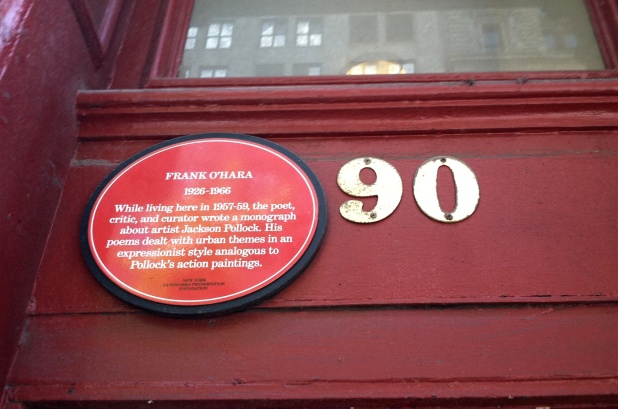One of my favorite places in New York is a particular stretch in Greenwich Village along University Place, about halfway between Washington Square Park and Union Square. Whenever I walk by the doorway at 90 University Place (now home to a crowded, hip café called The Grey Dog), I remember Frank O’Hara lived in that building for a couple of years of manic and brilliant creativity, from 1957 to 1959. As O’Hara’s roommate, friend, and occasional lover Joe LeSueur recalled in his piece “Four Apartments,” a wonderful memoir of the decade he spent living with O’Hara, the University Place apartment (the second of the four they shared) was a “fair-sized loft apartment” that they moved into “because we wanted to live downtown.” They loved the location, “which put us within walking distance of most of our friends’ places and just down the street from the Cedar, where Frank could slip in for a talk with the painters he was so crazy about.” (Long before the Grey Dog was on the ground floor, apparently it was quite a different kind of place, judging from O’Hara’s 1957 poem that begins, rather blithely and boldly for those blinkered times, “I live above a dyke bar and I’m happy“).
Years ago, I noticed that someone at the New York Landmarks Preservation Foundation had had the good sense to place a small red plaque above the doorway at 90 University Place to commemorate this fact. I was surprised to learn recently that there’s no easily accessible image of this plaque on the web — so as a public service, here’s a photograph of the plaque that I took a few years ago.
While I love the fact that this plaque exists, I’ve always been bugged by what it says — “While living here in 1957-1959, the poet, critic, and curator wrote a monograph about Jackson Pollock. His poems dealt with urban themes in an expressionist style analogous to Pollock’s action paintings.”
Clearly, whoever wrote that text wanted to link O’Hara with the much more famous Jackson Pollock. Needless to say, O’Hara did so many things in those years that could be considered more important than writing his monograph on Pollock, as ground-breaking as that work is. And to say that O’Hara wrote poems in an “expressionist style analogous to Pollock’s action paintings” is not only inaccurate and oversimplified, but smacks of someone trying to lend O’Hara borrowed glamour he doesn’t particularly need. As it’s been there for several decades, presumably the plaque went up at a time when O’Hara’s reputation was less secure than today (thanks to Mad Men, of course — just kidding! See here). Maybe this kind of justification was deemed necessary to warrant a historical marker. But oh well: at least there’s some reminder that an extraordinary poet lived in that little brick building, steps away from where the Cedar Tavern used to be.
I was reminded of this plaque the other day when I saw an announcement for an event called “Frank O’Hara Lived Here: Historic Plaque Unveiling and Community Celebration
at the Former Residence of Frank O’Hara.” Apparently, New York is about to get another plaque denoting one of O’Hara’s apartments — this one on E. 9th St., O’Hara’s third New York apartment, just steps away from Tompkins Square Park.
I used to live a few blocks away and would deliberately walk past this humble, nondescript building all the time too, thinking: one day, someone ought to put a plaque on this doorway too. Apparently that’s finally happening.
Sponsored by the Greenwich Village Society for Historical Preservation (which is responsible for the plaque, in conjunction with Two Boots) and the Poetry Project at St. Marks, the event will take place on Tuesday, June 10, starting at 6:00 P.M., and will feature readings by Tony Towle and Edmund Berrigan.
O’Hara and LeSueur moved from University Place to the E. 9th St. building in 1959, right in the midst of what is generally considered the high point of O’Hara’s writing career (Bill Berkson once referred to 1959 as O’Hara’s “annus mirabilis”). LeSueur mentions that “by early summer 1959, when we’d been living there only a few months, we realized we’d made a terrible mistake,” thanks to the alcoholic super, the cockroaches, “a black rat the size of a well-fed cat.” Even Tompkins Square Park “turned out to be a disappointment; in those pre-hippie days it was a bleak and forbidding place frequented by disgruntled old people.”
Despite all that, O’Hara’s work flourished. As LeSueur puts it, “it was here Frank probably reached the high point in his writing, both in productivity and quality.”
So, this is exciting news: on June 10, there will be an unveiling of a new plaque on the front of O’Hara’s old rat-infested East Village digs, along with a celebration of his work and life. I’m curious to see what the plaque says — I doubt O’Hara will be cast as an interesting footnote to Jackson Pollock this time around.


